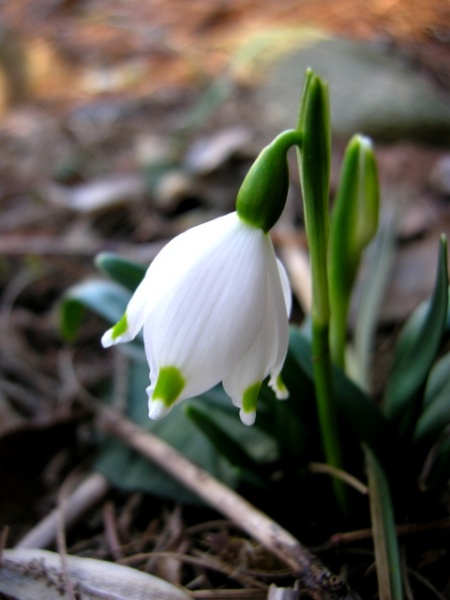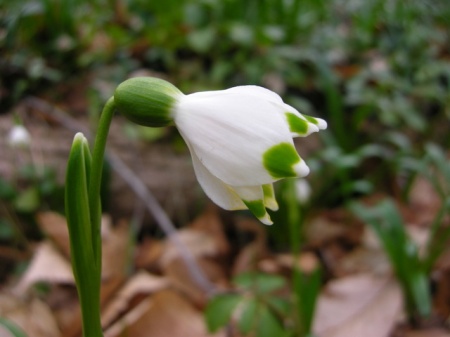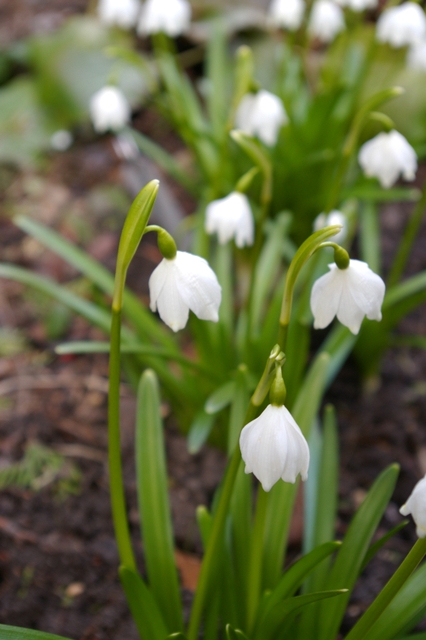Snowflakes (Leucojum) Continue the Snowdrop Season

Summer snowflake with Celandine poppy in the woodland at Carolyn’s Shade Gardens.
Our current snowdrop catalogue is on line here.
When snowdrops are finishing, their close relatives, snowflakes (Leucojum), are ready to take over the display. They are quite beautiful, but haven’t been subjected to the intense selection process that has resulted in over 1,500 snowdrop cultivars. They are very easy to grow, and I think they deserve more attention.
Nursery News: Carolyn’s Shade Gardens is a retail nursery located in Bryn Mawr, PA, specializing in showy, colorful, and unusual plants for shade. The only plants that we ship are snowdrops and miniature hostas. For catalogues and announcements of events, please send your full name, location, and cell number (for back up use only) to carolyn@carolynsshadegardens.com. Click here to get to the home page of our website for catalogues and information about our nursery and to subscribe to our blog.
.
 Leucojum aestivum in my woodland in April.
Leucojum aestivum in my woodland in April.
.
There are two main species of snowflakes: Leucojum aestivum or summer snowflake and Leucojum vernum or spring snowflake. Summer snowflake blooms in April in our area so the common name is very confusing. It is a large and vigorous plant reaching 12 to 18 inches with multiple green-tipped, white, lantern-shaped flowers at the end of each flower stem.
It likes moist soil but grows quite well in my dry woodland as you can see from the photos. It grows in dappled woodland conditions but also quite sunny spots and seeds aggressively in my garden. Summer snowflake is native to Central and Eastern Europe. The cultivar ‘Gravetye Giant’ has bigger flowers, but I have not grown it.
.
Spring snowflake
Spring snowflake, Leucojum vernum, blooms in March in our area so it could easily be called winter snowflake. On its own, it is a diminutive plant reaching 6 to 9 inches with single, green-tipped, white, lantern-shaped flowers at the end of each flower stem. The leaves are strap-shaped and a very pretty glossy, bright green. It likes moist soil but grows quite well in average moisture conditions in deciduous shade to part shade locations. Spring snowflake is native to Central and Southern Europe.


A clump of spring snowflake.
.

.
A hillside of spring snowflake in mid-March at Winterthur.
.
Spring snowflake combined with Amur adonis and glory-of-the-snow in mid-March at Winterthur.
There are some named forms of Leucojum vernum, which are quite interesting:
.

Leucojum vernum var. wagneri (or vagneri) produces two flowers on each stem, although none of mine did that this year. I have read that it is no longer a valid variety. If you visit naturalized populations of Leucojum vernum, a certain percentage will have twin flowers. This photo shows a wagneri with standard-shaped flowers and green spots.
.
This wagneri has the yellower spots typical of var. carpathicum pictured below.
.

Leucojum vernum var. carpathicum has yellow spots on each petal instead of the normal green spots.
.

‘Null Punkte’ from Germany is pure white with no spots.
.
‘Gertrude Wister’ is a semi-double spring snowflake with 12 or more petals instead of the normal 6. It was discovered by noted bulb expert Gertrude Wister in her garden on the Swarthmore College campus in Pennsylvania, US.
.
A group of ‘Gertrude Wister’. Carolyn’s Shade Gardens is honored to be the only source for this cultivar.
.
The surface has barely been scratched though—there are many beautiful forms under evaluation:
.

A form with 8 petals found in Charles Cresson’s garden. This is the one I want.
.

This lovely flower appeared in the midst of a group of var. wagneri. It has the spots, but then the very pointy tips are dipped in green paint.
.

A similar paint-dipped flower, but this one is outward facing, even more pointy, and has more color.
.

A very large flower with much more prominent spots.
.

A very large-flowered wagneri.
.

A wagneri with more separated petals.
.

A very large flower with alternating spotted petals and pure white petals.
.

Two flowers fused on the same stem: we will have to see if this repeats itself.
.

A true double flower under evaluation by a friend in Belgium.
.

Very beautiful!
Carolyn
.
Note: Every word that appears in orange on my blog is a link that you can click for more information. If you want to return to my blog’s homepage to access the sidebar information (catalogues, previous articles, etc.) or to subscribe to my blog, just click here.





March 17, 2016 at 5:56 pm
I love these too….crazy weather is limiting the blooms and now it is getting into the 30s/20s again. A strange spring in the garden.
March 17, 2016 at 6:26 pm
Donna, My nursery is stocked with plants and the temperatures are falling to 24 degrees here. Another year of moving everything inside, my least favorite job. Carolyn
March 17, 2016 at 6:13 pm
For your information: In Denmark these are called Dorothea lilies – which I think sounds rather glamorous for such a petite and subtle flower. I have always been fond of them, perhaps because they take over where the snowdrops begin to fade a little – and they have such staying power even in vases.
But they truly are elegant little flowers in their own right. That green droplet…
(And by sheer luck I have them in moderate numbers in my new garden. The snowdrops are immoderate – so will be shared with friends, because won’t they enjoy being divided? In my mind you are the Queen of Snowdrops, so who better to ask…)
March 17, 2016 at 6:25 pm
Soren, So glad you appeared here as we haven’t “talked” in a while. Snowflakes are indeed one of the more elegant flowers. I like that “Queen of Snowdrops”, commanding. Yes, snowdrops that have gotten into tight clumps can stop blooming so by all means divide them and share the fun. I divide mine now and was just doing that today! You need to find out what is the right time to divide in your climate. Carolyn
March 17, 2016 at 6:55 pm
I have tight clumps of snowdrops in the borders and I have random appearances throughout the lawn… In fact they are rather widespread in the lawn – which gives me confidence that I bought the right house and garden! I mean, if snowdrops can be happy here, so can I!
I imagine the right time to be when the blooms are going off but the leaves are still green – is that a wrong assumption?
March 17, 2016 at 9:08 pm
That’s a great time.
March 17, 2016 at 6:16 pm
great post!
March 17, 2016 at 6:21 pm
Thanks, Len, I just got excited about leucojum and wanted to organize my thoughts and photos. Carolyn
March 17, 2016 at 8:01 pm
Carolyn, I just emailed my cousin about visiting your nursery. Tell me when it is a good time for her to get your advice on what plants she can purchase for her woodland garden. It has many critters feasting, so that is a consideration. I have posted on her garden a few times, (not Barb in St. Lucia, Pat in PA), you might remember the property.
March 17, 2016 at 9:12 pm
Donna, For wildflowers and native woodland plants, the best time is mid-April before my second open house sale on April 16. If she is especially interested in hellebores, which maybe she is for critter resistance, then now is a good time. Thanks for the referral. Carolyn
March 17, 2016 at 10:36 pm
I’ve never developed a fondness for for snowdrops or snowflakes because, with snow on the ground from November to April, I am heartily sick of white by the time spring flowers appear. But this year, with very little snow and all of it having melted away by mid-March, I’m thinking how nice it would be to have some of those flowers brightening up the drab late-winter woods.
March 18, 2016 at 7:25 am
Jean, I love snowdrops for just that reason. They bloom when it is cold and snowy and cheer me up. You can come back down here. We are having a snowstorm on Sunday and then low temperatures in the mid-20s for a few days. Carolyn
March 18, 2016 at 7:29 am
Oh No! First a Galanathus addition, now Leucojum.
Great photos at Winterthur. It was a great photo day
March 18, 2016 at 7:38 am
Janine, I ran around the Winterthur gardens hurriedly taking pictures because I had to get back to the sale. But it was such a treat to be there for the first time when the leucojum was blooming. Carolyn
March 19, 2016 at 10:21 pm
That field of spring-flowering bulbs is so beautiful! You always share such beautiful photos and great information. Happy spring!
March 20, 2016 at 9:04 am
Happy Spring, Beth, I just wish it would make up its mind to stay here and not revert to winter. Carolyn
April 5, 2016 at 6:21 pm
You always have the neatest things. I love the massed snowflakes and all the interesting flower variations. ‘Gertrude Wister’ is stunning!
April 6, 2016 at 7:32 am
Thanks, Jennifer. People are of two minds about ‘Gertrude Wister’—-they either love it or hate it. Gertrude herself was not a fan. Carolyn
April 8, 2016 at 10:47 pm
Thanks for all the info Carolyn, I have never grown snowflakes, every time I look at the price of them I find something else I need much more – and I end up another year without them. But I can see how it easily can become a craze for the right snowflake, just like snowdrops! Next year I might invest in a small clump and then just carefully divide – they are so pretty.
All the crocuses and snowdrops are finished in my garden, I have late daffodils and tulips now – and despite the cold weather the roses are starting to produce flower buds.
April 9, 2016 at 8:12 am
Helene, Leucojum aestivum is usually inexpensive. Leucojum vernum is in the Avon Bulbs 2016 catalogue for 3 for 6.50 pounds—very reasonable compared to US prices. Carolyn
April 9, 2016 at 8:23 am
I suppose it might be reasonable, everything is relative…. I just compare it with other spring bulbs, I can get 100 snowdrops or crocuses for £9 or 100 aconite for £15. Where I buy bulbs they have 10 Leucojum Vernum and 25 Gravetye Giant each for £20 so they haven’t made it to the order list yet – but I would like to 🙂
April 11, 2016 at 8:23 am
I see your point!
April 12, 2016 at 5:33 pm
The photos of masses snowflakes at Winterthur are amazing. I love my own snowflakes, but you have opened my eyes to the different varieties.
April 13, 2016 at 8:42 pm
Not sure if you’ve covered this one on your blog Carolyn, but when I saw it I immediately thought of you.
http://www.gardenista.com/posts/garden-visit-snowdrop-season-at-painswick-rococo-garden?utm_source=remodelista&utm_medium=pubexchange
April 18, 2016 at 7:16 am
Thanks, Patty. I hadn’t seen that article. I added Painswick to my list of gardens to visit when I go to England next February! Carolyn